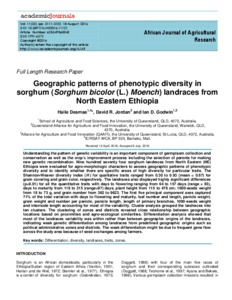Geographic patterns of phenotypic diversity in sorghum (Sorghum bicolor (L.) Moench) landraces from North Eastern Ethiopia
Abstract
Understanding the pattern of genetic variability is an important component of germplasm collection and conservation as well as the crop’s improvement process including the selection of parents for making new genetic recombination. Nine hundred seventy four sorghum landraces from North Eastern (NE) Ethiopia were evaluated for agro-morphologic characters to assess geographic patterns of phenotypic diversity and to identify whether there are specific areas of high diversity for particular traits. The Shannon-Weaver diversity index (H′) for qualitative traits ranged from 0.30 to 0.93 (mean = 0.67) for grain covering and grain color, respectively. The landraces also displayed highly significant differences (p<0.01) for all the quantitative traits with days to flowering ranging from 64 to 157 days (range = 93), days to maturity from 118 to 215 (range=97) days, plant height from 115 to 478 cm; 1000-seeds weight from 18 to 73 g, and grain number from 362 to 9623. The first five principal component axes captured 71% of the total variation with days to flowering and maturity, leaf number and length, panicle weight, grain weight and number per panicle, panicle length, length of primary branches, 1000-seeds weight and internode length accounting for most of the variability. Cluster analysis grouped the landraces into ten clusters. The clustering of zones and districts revealed close relationship between geographic locations based on proximities and agro-ecological similarities. Differentiation analysis showed that most of the landraces variability was within rather than between geographic origins of the landraces, indicating weak genetic differentiation among landraces from predefined geographic origins such as political administrative zones and districts. The weak differentiation might be due to frequent gene flow across the study area because of seed exchanges among farmers

